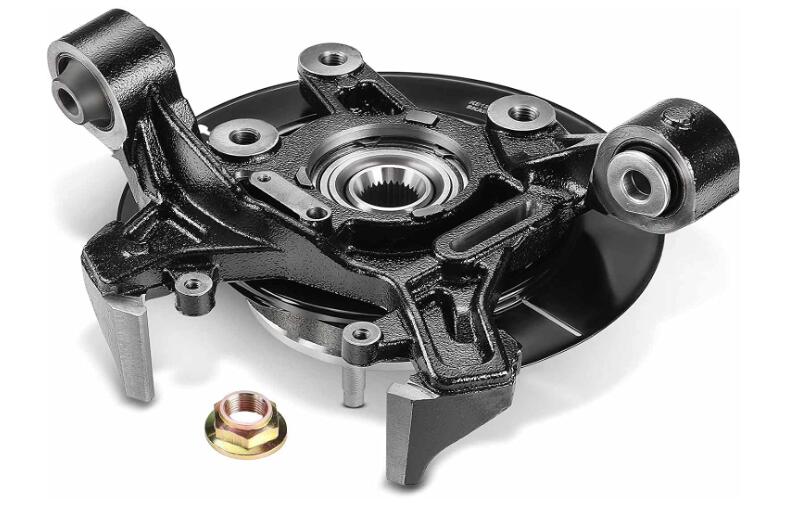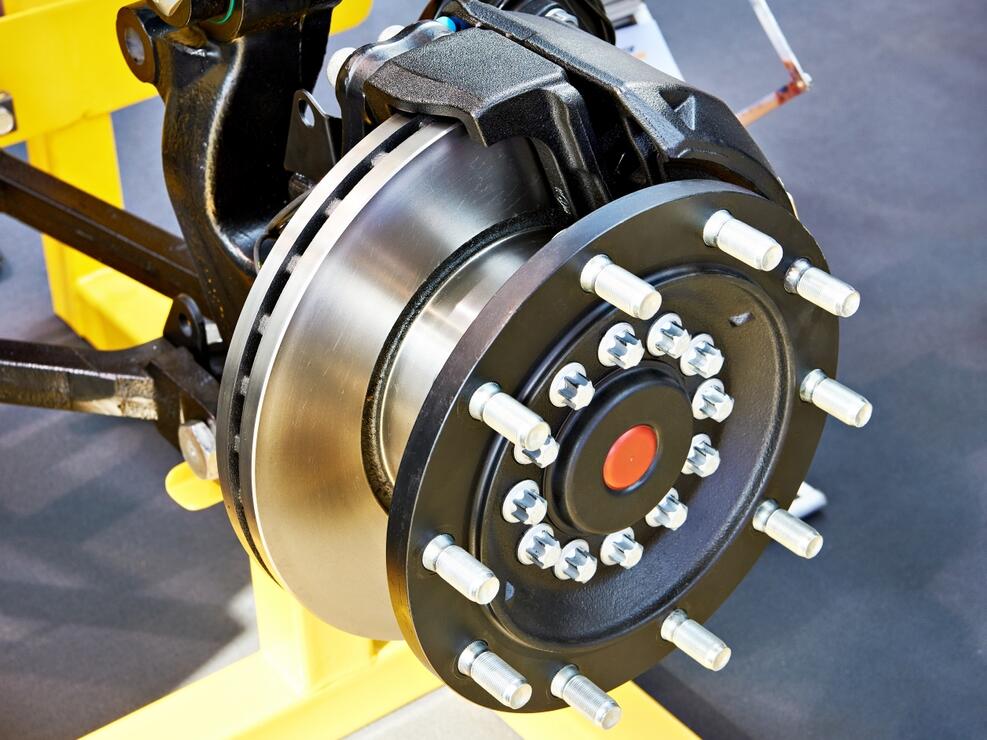Introduction
As a wheel hub and bearing assembly manufacturer, we recognize the growing importance of electromechanical wheel hub assemblies in developing smart vehicles.
This technology integrates sensors and actuators into the wheel hub assembly, enabling vehicles to adapt to varying driving conditions and enhance overall performance, safety, and efficiency.
In this in-depth article, we will discuss the concept of electromechanical wheel hub assemblies, their potential applications in smart vehicles, and the benefits they can offer to both vehicle manufacturers and drivers.

The Concept of Electromechanical Wheel Hub Assemblies
Electromechanical wheel hub assemblies represent a significant advancement in wheel hub technology.
By integrating sensors and actuators directly into the wheel hub assembly, these systems can monitor various aspects of the vehicle’s performance, such as wheel speed, torque, and temperature, and adjust various components in real-time to optimize performance and safety.
These integrated sensors and actuators can communicate with the vehicle’s central control unit, which processes the data collected and adjusts accordingly.
For example, the system may detect a loss of traction on one wheel and automatically apply the brakes or adjust the power distribution to maintain stability and control.
By integrating these electronic components into the wheel hub assembly, manufacturers can simplify the vehicle’s overall design, reduce the number of individual parts, and minimize potential points of failure.
This results in a more reliable, efficient, and streamlined vehicle architecture.

Potential Applications of Electromechanical Wheel Hub Assemblies in Smart Vehicles
Electromechanical wheel hub assemblies offer a range of potential applications in smart vehicles, including:
- Active suspension systems: By monitoring wheel speed, position, and load data, electromechanical wheel hub assemblies can adjust the vehicle’s suspension system in real-time to optimize ride comfort and handling. This helps maintain consistent vehicle dynamics and improve overall performance.
- Traction and stability control: Integrated sensors can detect wheel slip and transmit this information to the vehicle’s control unit, which can adjust the power distribution and braking to maintain optimal traction and stability in various driving conditions.
- Autonomous driving: Electromechanical wheel hub assemblies can provide critical data on wheel performance and position, which is essential for autonomous vehicles’ safe and effective operation. By constantly monitoring the vehicle’s wheels, these systems can help to ensure that the vehicle maintains its intended path and responds appropriately to changes in the driving environment.
- Electric propulsion: In electric vehicles, electromechanical wheel hub assemblies can integrate electric motors directly into the wheel hub, simplifying the overall design and improving powertrain efficiency. This can help maximize electric vehicles’ range and performance while reducing weight and complexity.
- Regenerative braking: Electromechanical wheel hub assemblies can also facilitate regenerative braking, which captures energy typically lost during braking and converts it into electricity to recharge the vehicle’s battery. This can improve the overall efficiency and range of electric and hybrid vehicles.

Benefits of Electromechanical Wheel Hub Assemblies for Vehicle Manufacturers and Drivers
The integration of sensors and actuators into wheel hub assemblies offers several benefits to both vehicle manufacturers and drivers:
- Simplified vehicle architecture: By incorporating electronic components directly into the wheel hub assembly, manufacturers can reduce the overall complexity of the vehicle, leading to lower production costs and improved reliability.
- Enhanced performance and efficiency: Electromechanical wheel hub assemblies can help to optimize vehicle performance and efficiency by monitoring and adjusting various components in real time. This can lead to improved handling, stability, and fuel economy.
- Improved safety: By providing real-time data on wheel performance and position, electromechanical wheel hub assemblies can help enhance vehicles’ safety by enabling advanced driver assistance systems (ADAS) and autonomous driving features. These systems can detect and respond to potential hazards more effectively, reducing the likelihood of accidents and improving overall safety on the road.
- Greater customization and adaptability: Electromechanical wheel hub assemblies can allow for greater customization of vehicle performance characteristics, such as suspension stiffness, ride height, and power distribution. By adjusting these parameters in real-time, drivers can tailor their vehicle’s performance to suit their preferences and the specific driving conditions they encounter.
- Reduced maintenance and repair costs: Integrating electronic components into the wheel hub assembly can help minimize potential points of failure and reduce the need for regular maintenance and repairs. This can lead to lower long-term ownership costs for drivers and improved overall vehicle reliability.

Challenges and Considerations for Implementing Electromechanical Wheel Hub Assemblies
While electromechanical wheel hub assemblies offer numerous benefits, there are also several challenges and considerations that manufacturers must address when implementing this technology:
- Cost: Integrating sensors and actuators into wheel hub assemblies can increase the overall cost of the system. Manufacturers must carefully balance the potential benefits of this technology with the increased production costs to ensure that the final product remains competitively priced.
- Durability: Electronic components integrated into wheel hub assemblies must be designed to withstand the harsh operating conditions typically encountered in automotive applications, including high temperatures, vibrations, and exposure to water, dust, and debris. Ensuring the durability and reliability of these components is crucial to maintaining the overall performance and longevity of the electromechanical wheel hub assembly.
- Compatibility: As the automotive industry continues to evolve and adopt new technologies, manufacturers must ensure that their electromechanical wheel hub assemblies are compatible with other vehicle systems and components. This may require close collaboration with other suppliers and vehicle manufacturers to develop integrated solutions that work seamlessly.
- Standardization and regulation: As electromechanical wheel hub assemblies become more widespread, there may be a need for greater standardization and regulation to ensure that these systems are safe, reliable, and compatible with other vehicle systems. Manufacturers should actively engage with industry organizations and regulatory bodies to help shape the development of these standards and guidelines.

Manufacturing Electromechanical Wheel Hub Assemblies: Embracing Innovation
As a wheel hub and bearing assembly manufacturer, embracing innovation and investing in research and development are crucial to staying competitive in the rapidly evolving automotive industry.
By adopting advanced manufacturing techniques and working closely with our industry partners, we can develop and produce electromechanical wheel hub assemblies that meet the high standards of performance, durability, and reliability demanded by our customers.
Key aspects of manufacturing electromechanical wheel hub assemblies include:
- Material selection: Choosing the right materials for the electronic components integrated into the wheel hub assembly is crucial for ensuring durability, reliability, and performance. We carefully select materials that can withstand the harsh automotive environment, including temperature extremes, vibration, and exposure to water, dust, and debris.
- Precision manufacturing: To produce electromechanical wheel hub assemblies with the necessary accuracy and consistency, we utilize advanced manufacturing techniques, such as computer numerical control (CNC) machining, injection molding, and additive manufacturing (3D printing). These technologies enable us to create complex component geometries with tight tolerances and ensure our products meet the highest quality standards.
- Quality control and testing: Ensuring our electromechanical wheel hub assemblies’ reliability and performance is paramount. We implement rigorous quality control processes and perform extensive testing to verify that our products meet or exceed industry standards and customer requirements.
- Collaboration and partnerships: Developing innovative electromechanical wheel hub assemblies often requires collaboration with other suppliers, vehicle manufacturers, and research institutions. By forging strong partnerships and actively participating in industry initiatives, we can stay at the cutting edge of wheel hub technology and deliver the best possible solutions to our customers.
By focusing on innovation, quality, and collaboration, we aim to be a leader in developing and producing electromechanical wheel hub assemblies, driving progress in the automotive industry, and contributing to the evolution of smart vehicles.

Electromechanical Wheel Hub Assembly Integration: Challenges and Solutions
Integrating electromechanical wheel hub assemblies into existing vehicle platforms can present several challenges for manufacturers and suppliers.
Identifying these challenges and implementing effective solutions ensures seamless integration and optimal performance.
Some of the primary challenges and their corresponding solutions include:
- Space constraints: Incorporating electronic components, such as sensors and actuators, into wheel hub assemblies can increase their size and complexity, potentially leading to space constraints within the vehicle’s wheel well. To overcome this challenge, manufacturers must focus on designing compact and efficient electromechanical wheel hub assemblies that minimize the space required for integration without compromising performance or durability.
- Interference with other vehicle systems: As the number of electronic systems within a vehicle increases, so does the potential for electromagnetic interference (EMI) between different components. This can lead to performance issues or even system failures in some cases. To mitigate this risk, manufacturers must carefully design and test their electromechanical wheel hub assemblies to ensure that they are shielded from EMI and do not adversely affect the performance of other vehicle systems.
- Integration with vehicle control systems: Seamless integration with the vehicle’s existing control systems is essential to operate electromechanical wheel hub assemblies effectively. Manufacturers must work closely with vehicle OEMs and suppliers to ensure their products are compatible with the vehicle’s control systems and communicate effectively with other components.
- Updating vehicle software: Incorporating electromechanical wheel hub assemblies into existing vehicles may require updates to the vehicle’s software to enable communication with the new components and ensure proper functioning. Manufacturers should provide software updates and support to vehicle OEMs and aftermarket suppliers to facilitate seamless integration.
- Training and support: Introducing electromechanical wheel hub assemblies into the automotive market may require additional training and support for service technicians and other industry professionals. Manufacturers should invest in providing comprehensive training materials, technical support, and other resources to ensure that their customers and partners have the necessary knowledge and expertise to work with these advanced systems effectively.
By addressing these challenges and implementing effective solutions, manufacturers can successfully integrate electromechanical wheel hub assemblies into existing vehicle platforms, paving the way for the widespread adoption of this innovative technology in the automotive industry.

Conclusion
Electromechanical wheel hub assemblies offer significant potential to revolutionize the automotive industry, enabling the development of smarter, safer, and more efficient vehicles.
As manufacturers, embracing innovation, investing in research and development, and overcoming the challenges of integrating these advanced systems into existing vehicle platforms is crucial.
By focusing on material selection, precision manufacturing, quality control, collaboration, and addressing integration challenges, we can create cutting-edge electromechanical wheel hub assemblies that meet the demands of today’s automotive market and contribute to the ongoing evolution of smart vehicles.
As a wheel hub and bearing assembly manufacturer, we are committed to staying at the forefront of this technology, providing our customers with the highest quality products and supporting the continued growth and development of the automotive industry.




